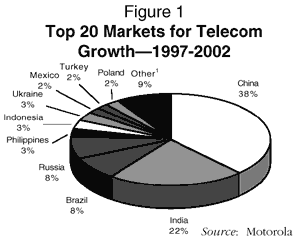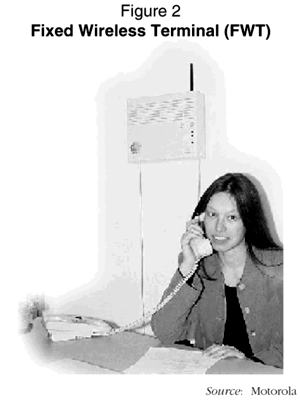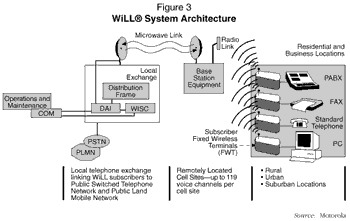
The growth of cellular technology has focused attention on another innovation: fixed wireless telephony, also referred to as wireless local loop (WLL). All the ingredients appear to be in place for another explosive breakthrough; the technology is there, and the demand is there. In fact, the potential demand, especially in emerging economies, is enormous. The breakthrough in fixed wireless telephony is particularly significant because of its potential to quickly help emerging markets leapfrog the technology gap.
Various sources estimate the number of currently-installed fixed wireless telephony lines worldwide to be around one million subscribers. The variance for the untapped potential is much larger, ranging from a conservative 20 million lines to an optimistic 80 million lines over the next five years (see Figure 1 and Table 1). Whatever the number, it is clear that the emergence of fixed wireless into the telephony market is just now beginning. Just as with telephony at the turn of the century and more recently cellular, the full impact of this fixed wireless breakthrough may not yet be fully comprehended.

| Table 1: Wireless Local Loop -- Market Focus | ||
|---|---|---|
| Country | Estimated New Lines (Millions) | Current Waiting List (2) (Millions |
| China | 55 (3), (4) | 1.0 |
| India | 30 (3), (4) | 2.3 |
| Brazil | 12 (4) | 3.6 |
| Russia | 11 (4), (5) | 11.0 |
| Philippines | 4 (4) | 0.7 |
| Indonesia | 4 (4), (5) | 0.3 |
| Ukraine | 4 (4), (5) | 4.0 |
| Mexico | 4 (4), (5) | 1.0 |
| Turkey | 3 (4), (5) | 1.4 |
| Poland | 3 (4), (5) | 2.3 |
| Other (1) | 14 (4), (5) | 1.4 |
| (1) Other = Nigeria, Argentina, Hungary, Colombia, Chile, Egypt, Uzbekistan, Venezuela, Peru, Thailand (2) 1992 ITU Telecom Indicators (3) Planned Lines (Interviews) (3) Planned Lines (Interviews) (4) GDP Algorithms (5) 1992 ITU Projections | ||
| Source: Motorola | ||
Motorola has delivered some of the largest wireless access systems in the world, two of which are:
This article describes some of the lessons learned in implementing large fixed wireless telephony systems. The challenge of deploying the system in Hungary was twofold:

The Matav wireless network was the first in the world to have the Motorola digital voice privacy feature provided by the Motorola Enhancement Device (MED). One of several new technological innovations, this feature prevents eavesdropping and provides privacy for calls. It uses a vocoder, or digital speech processor, to encode the transmitted voice signals using a randomly-generated algorithm during call set-up.
Like the PSTN, Motorola's WLL system in Hungary provides digitally enhanced, high quality, fully featured voice, fax, and data services. It also provides an important feature called network transparency. This feature enables the dialtone to be transmitted directly from the PSTN switch. In contrast, other wireless systems may generate a fake dialtone at the FWT, thereby blocking many of the standard landline features such as call-waiting.
Another key feature for the Hungarian telecommunications network operator is the ability to transmit billing pulses from the central switch. This important feature enables the system to support both coin and card-operated payphones.
The architecture of Motorola's WiLL® system in Hungary is illustrated in Figure 3.

Access to modern telecommunications is a vital prerequisite for economic growth and social development. For the countries of Central Europe, growing their economies and creating wealth and employment, deploying an advanced national telecommunications infrastructure is essential if their future is to be assured. Long-term ambitions to become part of a larger European community cannot be achieved without both national and international telecommunications links.
Hungary has a population of 10 million people, but only two million telephones. A telephone density of 20%, although above the world average, falls short of the Western European average teledensity of around 50%. In 1994, the waiting list for telephone connection totalled almost 700,000 people, a figure which the Hungarian national telecommunications operator Matav is determined to reduce by the end of the century.
Hungary has a mix of modern and antiquated PSTN equipment. The equipment in the network ranges from modern digital switches, particularly in and around Budapest, to old analog crossbar switches across the country. Some remote villages were still using manual patch panel switches in 1996. In contrast, Hungary has highly-trained engineers who are intimately familiar with the newest developments in telephony, as well as the most modern ETSI and FCC standards.
Matav's targets are to:
To achieve these targets through traditional methods, such as laying copper or fiber optic cable, would be time-consuming, expensive, disruptive, and, in the case of Hungary's remote rural areas, not practical. Matav therefore decided to choose an alternative route and deploy a national wireless local loop network.
This WiLL® system had to be able to respond to two major challenges:
Installation of the Matav network began in September 1995, and the first 600 commercial subscribers, located in a rural area of Hungary, were able to begin making calls in November 1995. The system reached the 100,000 commercial capacity level by the end of 1996, and the full 200,000 subscriber network is due for completion by the end of 1997. At that point, Hungary will have the world's second largest wireless local loop network. (Motorola's fixed adapted cellular system in Spain is the largest.)
From the start, the Hungarian operator expected Motorola's fixed wireless telephony system to provide features and quality that could compete with landline systems. This meant the elimination of call set-up delays which are inherent in many wireless telephony protocols. This also meant landline-compatible dial success ratios, clear DTMF touch-tone dialing, echo cancellation, and low data transmission bit error rates. But, most of all, this meant clear, crisp audio -- none of the noise or interference that is forgiven in other areas of wireless communications.
Another challenge was in the area of operations and maintenance. The system had to include the ability to monitor and control both the infrastructure and subscriber fixed wireless terminals from regional maintenance centers. The system was specified by a joint team from both Motorola and Matav based on common landline-type operations and maintenance features.
The FWT presented its own challenges. It differs from a cellular phone in at least one basic area -- it is not mobile. As a fixed unit, it cannot be removed from the home or office by the subscriber. While cellular or landline phones can be brought in for service, this is not the case with the FWT.
To address this challenge, Motorola developed a remote test feature for the FWT as part of the operations and maintenance system. In many cases, the operator can remotely test and diagnose the FWT without visiting the subscriber's home. This important feature does not just increase test efficiency and reduce test time, it also reduces the maintenance costs, as subscriber visits can be expensive.
Other challenges included PSTN signaling such as hook flash and call set-up and completion. These issues were resolved through special solutions developed at Motorola to improve the standard cellular protocols by communicating directly with the PSTN switch, rather than signaling via the standard cellular communications protocol.
By far, one of the most demanding challenges in Hungary was the need to merge the new system into a diverse and complicated country-wide network. This required an understanding of the network audio levels, which could be different for each type of switch in the network. This, in turn, impacted many audio characteristics of the WiLL® system, such as echoes. Motorola worked closely with the Hungarian national telecommunications operator to resolve these issues and to determine the various parameters required for optimal system performance.
As mentioned earlier, Hungary afforded an excellent environment for Motorola to perfect unique wireless solutions. The wide range of equipment in the country, a well-equipped telephony test and certification center in Gyor (about 100 kilometers from Budapest), the high level of the local engineering talent, and the cooperation of the customer all combined to provide an opportunity to bring the wireless system much closer to landline in performance, quality, and features. As a result, the improvements later became standard with the WiLL® system worldwide.
Among the lessons that were learned, probably the most important was the need for very close cooperation between the customer and Motorola. Wireless technology is still evolving and improving, therefore setting expectations with the customer at the start of the project is essential.
The customer expected fast deployment, and this expectation was met. Of all the benefits of wireless telephony, speed of deployment was -- and is -- the most significant. Deployment of a wireless system is usually measured in months rather than years. The customer could also expect reduced cost in laying infrastructure compared with landline, especially in rural areas. Also, in some cases, maintenance costs could be expected to be less.
It was also important, however, to ensure that customer expectations took into consideration the obstacles that had to be overcome. Deployment of wireless telephony is very different from the deployment of landline. It is not just a question of base stations versus copper or fiber; it also involves RF planning, overcoming RF interference, wireless system configuration and parameter settings, and correct FWT installation. In fact, correct FWT installation was a major hurdle that needed to be overcome as quickly as possible.
FWT installation requires training and initial supervision of the installation teams until adequate experience has been gained. This includes:
It also includes making sure the subscriber understands the new service. In one case, a subscriber disconnected the FWT from the power supply, and would connect it only when making a call. The subscriber was subsequently unhappy that there were no incoming calls.
In addition to improvements made during the delivery of the WiLL® system to Hungary, Motorola also worked closely with the local operator to identify the cause of problems in the field. In Budapest, a different wireless system was found to be transmitting on frequencies that had been allocated to WiLL®. In other cases, natural obstructions which impacted system performance were overcome using external antennas.
Motorola also worked with Matav to define suitable equipment and tests to evaluate the performance of the WiLL® system at Gyor before deployment. New system releases, new features, and system improvements were all evaluated and approved at the test center before being released to the field. One of the basic lessons learned during this phase was that the standard tests used for landline systems were not always the most appropriate for a wireless system. Special tests and scripts were developed to ensure that there were no unacceptable audio interruptions, misdials, etc., and to test the specific components of the WiLL® system.
As mentioned previously, plans are to have a 200,000 subscriber network completed by the end of 1997. Motorola continues to work closely with the Hungarian operator as more improvements are introduced into the system. In addition, the full operations and maintenance system, specified jointly by the customer and Motorola, will be deployed during the next several months.
The lessons learned in Hungary have been used in customer solutions worldwide:
This means that other WiLL® systems are now being installed more rapidly. In fact, Motorola now provides a rapid deployment system mounted on a truck to handle emergencies in cases of natural disasters or regional loss of standard telephone service.
In addition to Spain and Hungary, a third large system is currently being launched by Motorola in the Philippines. Other smaller systems are already in place in Africa, South America, and Asia. The experience gained from these systems has enabled Motorola to develop new technology and provide additional features. New digital technology, such as GSM and CDMA, is being applied in a wide range of frequencies, including 1.7 and 1.9 gigahertz, with more efficient spectrum utilization.
All indications are that fixed wireless telephony is indeed one of the major technological breakthroughs. As more systems are installed throughout the world, the difference between landline and wireless may well shrink. Whether this difference will ever be totally eliminated is debatable -- as wireless technology improves, so does landline.